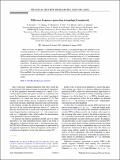| dc.contributor.author | Zhang, Yang | |
| dc.date.accessioned | 2020-05-26T18:10:19Z | |
| dc.date.available | 2020-05-26T18:10:19Z | |
| dc.date.issued | 2020-01-15 | |
| dc.identifier.issn | 2643-1564 | |
| dc.identifier.uri | https://hdl.handle.net/1721.1/125455 | |
| dc.description.abstract | When two lasers are applied to a noncentrosymmetric material, it can generate light at the difference of the incoming frequencies Δω, a phenomenon known as difference frequency generation (DFG), well characterized in semiconductors. In this work, we derive a general expression for DFG in metals, which we use to show that the DFG in chiral topological semimetals under circular polarized light is quantized in units of e^{3}/h^{2} and independent of material parameters, including the scattering time τ, when Δω≫τ^{−1}. In this regime, DFG provides a simpler alternative to measure a quantized response in metals compared to previous proposals based on single frequency experiments. Our general derivation unmasks, in addition, a free-carrier contribution to the circular DFG beyond the semiclassical one. This contribution can be written as a Fermi surface integral, features strong frequency dependence, and oscillates with a π/2 shift with respect to the quantized contribution. We make predictions for the circular DFG of chiral and nonchiral materials using generic effective models, and ab initio calculations for TaAs and RhSi. Our work provides a complete picture of the DFG in the length gauge approach, in the clean, noninteracting limit, and highlights a plausible experiment to measure topologically quantized photocurrents in metals. | en_US |
| dc.publisher | American Physical Society | en_US |
| dc.relation.isversionof | http://dx.doi.org/10.1103/PhysRevResearch.2.012017 | en_US |
| dc.rights | Creative Commons Attribution 4.0 International license | en_US |
| dc.rights.uri | https://creativecommons.org/licenses/by/4.0/ | en_US |
| dc.source | American Physical Society | en_US |
| dc.title | Difference frequency generation in topological semimetals | en_US |
| dc.type | Article | en_US |
| dc.identifier.citation | Juan, F. de et al. “Difference frequency generation in topological semimetals.” Physical review research 2 (2020): 012017 © 2020 The Author(s) | en_US |
| dc.contributor.department | Massachusetts Institute of Technology. Department of Physics | en_US |
| dc.relation.journal | Physical review research | en_US |
| dc.identifier.mitlicense | PUBLISHER_CC | |
| dc.identifier.mitlicense | PUBLISHER_CC | |
| dc.eprint.version | Final published version | en_US |
| dc.type.uri | http://purl.org/eprint/type/JournalArticle | en_US |
| eprint.status | http://purl.org/eprint/status/PeerReviewed | en_US |
| dc.date.updated | 2020-01-15T15:11:07Z | |
| dc.language.rfc3066 | en | |
| dspace.date.submission | 2020-01-15T15:11:07Z | |
| mit.journal.volume | 2 | en_US |
| mit.metadata.status | Complete | |
